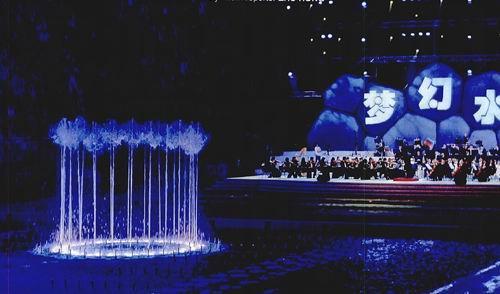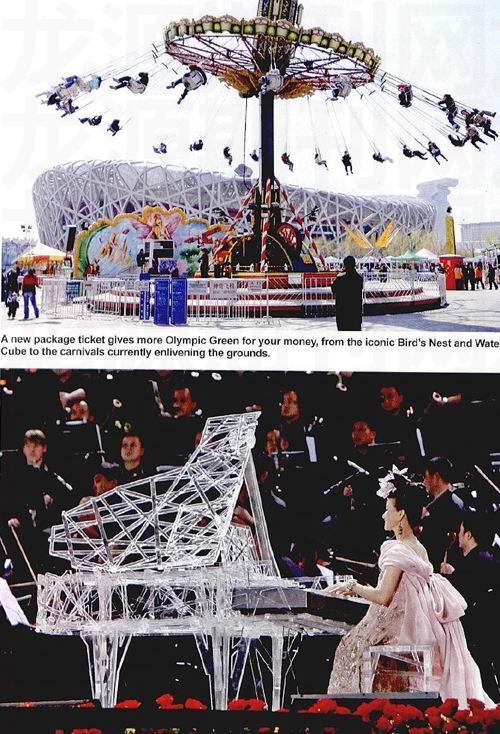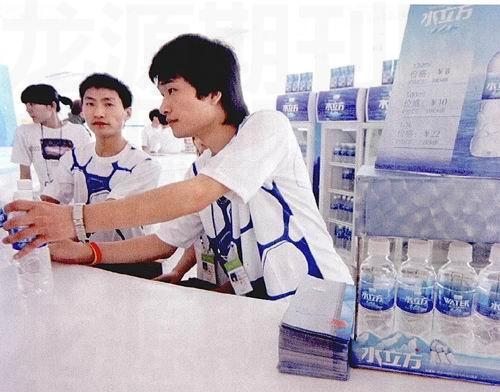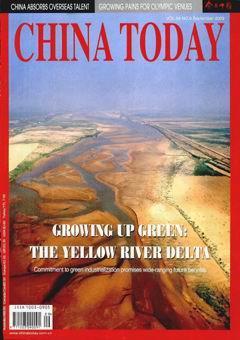Growing?。校幔椋睿蟆。妫铮颉。希欤恚穑椋恪。郑澹睿酰澹?/h1>
2009-10-30 07:46:18ZHUHONG
CHINA TODAY 2009年9期
ZHU?。龋希危?/p>
The joint-investors model eliminates the investment risk of not only the government, but also the private partner.

TO cater to tourists and students during the summer holidays, the Beijing Olympic Green is now offering a package ticket, which includes admission not only to the hottest sites in the park such as the Birds Nest and the Water Cube, but also the carnivals currently enlivening the grounds. The package can save tourists up to 50 percent off of single, separate entry fees.
Post-Games repurposing of the Olympic venues amounts to more than marketing; it includes the gradual refurbishment of the interior of the Birds Nest for a start. Its third floor will be built into a loop-like Olympic-themed restaurant, displaying through photos and videos the Beijing Olympic Games preparation, spectacular competitive highlights, and venue construction; the Birds Nest will have its own particular showcase of photos, videos and models.
The transformation of the Birds Nests facilities for commercial interests will remake an area of some 100,000 square meters. According to the current plan, 56 stores selling ethnic commodities and sports goods will be housed inside. Relevant officials of the Chaoyang District Tourism Bureau say that the interiors of the National Indoor Stadium, the Olympic Forest Park and some other venues will also be commercialized in the latter half of 2009.
With new retail and dining elements, as well as tour packages for the Olympic Green, the Olympic facilities once again earn the publics attention.

A Risk-sharing Operating Model
“In fact, the designs of the original Olympic venues had already taken into consideration post-Game utilization. Many competition venues were built in densely populated areas or universities, to be readily accessible to ordinary citizens,” says Lin Xianpeng, executive director of Beijing Olympic Economy Research Association.
The Olympic venues are mainly concentrated in four zones in north and west Beijing. The central zone is in the Olympic Green, while the other three zones are located in western residential areas, northern scenic areas, and universities respectively. The central zone where the venues and facilities form a dense and unified “playground” is scaled for high-grade exhibitions, sports events and leisure or business activities. Wukesong Culture and Sports Center fills a gap in west Beijing, which has always lacked a large sports center, and is already being enjoyed by the community. The northern scenic area has become a tourism hotspot in its own right. Other venues scattered across six university campuses, mostly in northwest Beijing, enable students to enjoy considerably improved sports facilities.
Multi-investor models, risk-sharing and professional management have been introduced into the construction and operation of the Olympic venues, as they ease the governments burden with respect to their post-Games operation for the public good and as revenue-generators. The Beijing CITIC Consortium and the Beijing State-owned Assets Management Co., Ltd. (BSAM) jointly set up the National Stadium Operation Co., Ltd. to manage the Birds Nest in terms of its financing, construction, management, operation, maintenance and handover. The company is also government-approved to hold the venues exclusive management rights for 30 years. The Birds Nest is the first Chinese stadium to follow the 3P or PPP model (Public-Private Partnership) of operation. This refers to government and private enterprise sharing the risk of operation. In contrast, the National Indoor Stadium, the National Conference Center and some others were Build-Operate-Transfer (BOT) projects, meaning that the investor is fully responsible for the design, financing, construction and operation of the project and eligible to profit from its use within a certain window of time, following which ownership is transferred to the government.
The joint-investors model eliminates the investment risk of not only the government, but also the private partner, because the latter took the venues future operation into consideration while designing its various functions. In this way, each partners rights, responsibilities and profit distribution are clearly set out at the start, and the venues are operated by professionals hired by private enterprises. The resulting risks are greatly minimized compared to the former model, wherein government sports administrators are left to run the venues after games.

A Commercial Focus
The Olympic Green still remains a must for many tourists though enthusiasm appears to be fading. However, curiosity cant support the venues operation over the long run, and tourism is just one of the many effective ways to make use of the venues. It is estimated that the Birds Nest needs 35 years of annual revenues amounting to at least US $30 million in order to recoup the RMB 3.6 billion investment already sunk into its construction and maintenance, plus loan interest. A single entry fee is only RMB 50 per person and now the number of visitors has shrunk from 80,000 per day at peak periods to 5,000 or 6,000 per day. The income from tickets declined precipitously on the conclusion of the Games. “Few people would spend RMB 50 to visit the historic spot again and again,” points out Wang Chun, executive deputy director of the Olympic Green Management Committee.
Hosting commercial performances and sports events is another major revenue-generator. During the National Day holiday last year, a symphonic concert titled “Dream of the Water Cube,” coupled with a musical water and light show, debuted at the National Aquatic Center. That was the first time the Water Cube was turned to commercial purposes. “We started thinking about the possible post-Game use of the Water Cube ever since we broke the ground for its construction,” mentions Kang Wei, board chairman of the National Aquatic Center Company. “Gradually we formed the idea of hosting concerts. We hope to create a sense of wonder by blending high technology and elemental art.” The audience for the “Dream of the Water Cube” was mainly tourists. They were gratified to be able to appreciate the performance as well as take a look at the unusual bubble or “molecule” design. Currently the ballet classic Swan Lake is being staged at the famous swimming pool, which creates an authentic, if somewhat unusual, setting for the work.

Besides the Water Cube, other venues, including the National Indoor Stadium, the National Conference Center, the Capital Indoor Stadium and the Workers Gymnasium, have all focused their energy on luring large-scale commercial performances. By the end of March this year, the National Indoor Stadium had set the stage for 22 high-end commercial activities, bringing in approximately RMB 20 million. Though the post-Game transformation of the National Conference Center will not be complete until November 2009, conference and exhibition bookings have been scheduled through to 2016, with nearly 70 of them for 2010.
By contrast, the Birds Nest management is more cautious and circumspect than other venues about what commercial activities it hosts. On the night of May 1 this year, the stadium mounted the concert “Jackie Chan and His Friends,” the first major public event within its walls since the Games ended more than eight months ago. Kung Fu star Chan drew a 50,000-strong audience that night, so the queue outside the only food store on the third floor was conspicuously long, and some 700 security guards were in place. One month later the “Charm of China” concert – the initial event of the “National Stadium Summer Concert Series” – opened, giving top billing to Chinese soprano Song Zuying, Spanish tenor Placido Domingo, Chinese pianist Lang Lang and Chinese pop idol Jay Chou. At 8 p.m. on August 8, exactly a year after the opening of the Beijing Olympic Games, the Italian Super Cup kicked off at the Birds Nest. The match was between the newly-crowned Series A champion Inter Milan and reigning Cup champions Lazio, and Lazio sank Inter Milan 2-1. According to the game organizing committee, ticket revenues exceeded RMB 70 million.
“The schedule for performances in the Birds Nest is full this year,” confirms Yang Weiying, executive deputy general manager of Beijing CITIC Consortium Stadium Operation Co., Ltd. He also stresses that shows aspiring to open at the Birds Nest must meet certain standards. “Events are carefully selected to reflect the world-class status of the Birds Nest arena, meaning high-profile national and international events are the ones that make the grade,” he adds.
Intangible Olympic Heritage
When it comes to the operation of the venues after the Olympics, many experts call for more attention to the idea of showcasing both their tangible and intangible properties. “It will add immeasurably to their successful post-Game operation if the intangible property of the venues can be effectively developed and marketed as well,” says Lin Xianpeng, executive director of Beijing Olympic Economy Research Association. “As to the ‘hard infrastructure and facilities, we can increase profits through rational planning and efficient use. However, intangible property, like brand influence, has even bigger potential.” He concluded, “The experience of developed countries shows that the largest profits from mega-stadiums are made in intangible property, such as naming rights and deluxe private room rental.”
For example, the name “Water Cube” is a trademark. In the summer of 2009, officials at the National Aquatic Center announced the market debut of Water Cube Glacial Water, the first product named after the venue. Soon after, “Water Cube” wine was jointly promoted by the National Aquatic Center and the Guizhou-based Kweichow Moutai Co., Ltd. A short period after that, the naming rights of the Birds Nest galvanized public attention. According to media reports, many big-name enterprises at home and abroad are still competing for naming rights to the Birds Nest. The bidders include Chinese computer manufacturer Lenovo, Coca-cola of America, and Germanys Adidas.The best offer so far is US $1 billion.
However, the development of intangible property isnt always smooth sailing. “Water Cube” glacial water hasnt become the big hit the investors were looking for and consumers seldom find it in the supermarkets. The price tag of RMB 11.8 doesnt help, especially against purveyors of potable water usually retailed at RMB 1 or 2. There is also some controversy brewing about the naming rights of the beloved Birds Nest. Some people believe that Olympic venues are symbols of national pride and inseparable from their Olympic fame, so a commercial label attached to any one of them now is cause for some discomfort.
However, Chen Jian, president of Beijing Olympic Economy Research Association, is optimistic about intangible property revenues from the Olympic venues. He reasons that the scale and quality of Beijing venues are comparable to past Olympic cities, and at the same time Chinas economy is heating up – with a large number of international consortiums headquartered in Beijing. So gaining the naming rights of the Birds Nest is an exceptional opportunity for enterprises to publicize and expand their brand influence. Conditions for developing intangible property, in many ways, couldnt be better. Beijing, the deep heart of the countrys sports success, is also a favorite of international sports organizers. It cant help but attract more and more cultural and sporting events.
Many big-name enterprises at home and abroad are still competing for naming rights to the Birds Nest with offers as high as US $1 billion.
ZHU?。龋希危?/p>
The joint-investors model eliminates the investment risk of not only the government, but also the private partner.

TO cater to tourists and students during the summer holidays, the Beijing Olympic Green is now offering a package ticket, which includes admission not only to the hottest sites in the park such as the Birds Nest and the Water Cube, but also the carnivals currently enlivening the grounds. The package can save tourists up to 50 percent off of single, separate entry fees.
Post-Games repurposing of the Olympic venues amounts to more than marketing; it includes the gradual refurbishment of the interior of the Birds Nest for a start. Its third floor will be built into a loop-like Olympic-themed restaurant, displaying through photos and videos the Beijing Olympic Games preparation, spectacular competitive highlights, and venue construction; the Birds Nest will have its own particular showcase of photos, videos and models.
The transformation of the Birds Nests facilities for commercial interests will remake an area of some 100,000 square meters. According to the current plan, 56 stores selling ethnic commodities and sports goods will be housed inside. Relevant officials of the Chaoyang District Tourism Bureau say that the interiors of the National Indoor Stadium, the Olympic Forest Park and some other venues will also be commercialized in the latter half of 2009.
With new retail and dining elements, as well as tour packages for the Olympic Green, the Olympic facilities once again earn the publics attention.

A Risk-sharing Operating Model
“In fact, the designs of the original Olympic venues had already taken into consideration post-Game utilization. Many competition venues were built in densely populated areas or universities, to be readily accessible to ordinary citizens,” says Lin Xianpeng, executive director of Beijing Olympic Economy Research Association.
The Olympic venues are mainly concentrated in four zones in north and west Beijing. The central zone is in the Olympic Green, while the other three zones are located in western residential areas, northern scenic areas, and universities respectively. The central zone where the venues and facilities form a dense and unified “playground” is scaled for high-grade exhibitions, sports events and leisure or business activities. Wukesong Culture and Sports Center fills a gap in west Beijing, which has always lacked a large sports center, and is already being enjoyed by the community. The northern scenic area has become a tourism hotspot in its own right. Other venues scattered across six university campuses, mostly in northwest Beijing, enable students to enjoy considerably improved sports facilities.
Multi-investor models, risk-sharing and professional management have been introduced into the construction and operation of the Olympic venues, as they ease the governments burden with respect to their post-Games operation for the public good and as revenue-generators. The Beijing CITIC Consortium and the Beijing State-owned Assets Management Co., Ltd. (BSAM) jointly set up the National Stadium Operation Co., Ltd. to manage the Birds Nest in terms of its financing, construction, management, operation, maintenance and handover. The company is also government-approved to hold the venues exclusive management rights for 30 years. The Birds Nest is the first Chinese stadium to follow the 3P or PPP model (Public-Private Partnership) of operation. This refers to government and private enterprise sharing the risk of operation. In contrast, the National Indoor Stadium, the National Conference Center and some others were Build-Operate-Transfer (BOT) projects, meaning that the investor is fully responsible for the design, financing, construction and operation of the project and eligible to profit from its use within a certain window of time, following which ownership is transferred to the government.
The joint-investors model eliminates the investment risk of not only the government, but also the private partner, because the latter took the venues future operation into consideration while designing its various functions. In this way, each partners rights, responsibilities and profit distribution are clearly set out at the start, and the venues are operated by professionals hired by private enterprises. The resulting risks are greatly minimized compared to the former model, wherein government sports administrators are left to run the venues after games.

A Commercial Focus
The Olympic Green still remains a must for many tourists though enthusiasm appears to be fading. However, curiosity cant support the venues operation over the long run, and tourism is just one of the many effective ways to make use of the venues. It is estimated that the Birds Nest needs 35 years of annual revenues amounting to at least US $30 million in order to recoup the RMB 3.6 billion investment already sunk into its construction and maintenance, plus loan interest. A single entry fee is only RMB 50 per person and now the number of visitors has shrunk from 80,000 per day at peak periods to 5,000 or 6,000 per day. The income from tickets declined precipitously on the conclusion of the Games. “Few people would spend RMB 50 to visit the historic spot again and again,” points out Wang Chun, executive deputy director of the Olympic Green Management Committee.
Hosting commercial performances and sports events is another major revenue-generator. During the National Day holiday last year, a symphonic concert titled “Dream of the Water Cube,” coupled with a musical water and light show, debuted at the National Aquatic Center. That was the first time the Water Cube was turned to commercial purposes. “We started thinking about the possible post-Game use of the Water Cube ever since we broke the ground for its construction,” mentions Kang Wei, board chairman of the National Aquatic Center Company. “Gradually we formed the idea of hosting concerts. We hope to create a sense of wonder by blending high technology and elemental art.” The audience for the “Dream of the Water Cube” was mainly tourists. They were gratified to be able to appreciate the performance as well as take a look at the unusual bubble or “molecule” design. Currently the ballet classic Swan Lake is being staged at the famous swimming pool, which creates an authentic, if somewhat unusual, setting for the work.

Besides the Water Cube, other venues, including the National Indoor Stadium, the National Conference Center, the Capital Indoor Stadium and the Workers Gymnasium, have all focused their energy on luring large-scale commercial performances. By the end of March this year, the National Indoor Stadium had set the stage for 22 high-end commercial activities, bringing in approximately RMB 20 million. Though the post-Game transformation of the National Conference Center will not be complete until November 2009, conference and exhibition bookings have been scheduled through to 2016, with nearly 70 of them for 2010.
By contrast, the Birds Nest management is more cautious and circumspect than other venues about what commercial activities it hosts. On the night of May 1 this year, the stadium mounted the concert “Jackie Chan and His Friends,” the first major public event within its walls since the Games ended more than eight months ago. Kung Fu star Chan drew a 50,000-strong audience that night, so the queue outside the only food store on the third floor was conspicuously long, and some 700 security guards were in place. One month later the “Charm of China” concert – the initial event of the “National Stadium Summer Concert Series” – opened, giving top billing to Chinese soprano Song Zuying, Spanish tenor Placido Domingo, Chinese pianist Lang Lang and Chinese pop idol Jay Chou. At 8 p.m. on August 8, exactly a year after the opening of the Beijing Olympic Games, the Italian Super Cup kicked off at the Birds Nest. The match was between the newly-crowned Series A champion Inter Milan and reigning Cup champions Lazio, and Lazio sank Inter Milan 2-1. According to the game organizing committee, ticket revenues exceeded RMB 70 million.
“The schedule for performances in the Birds Nest is full this year,” confirms Yang Weiying, executive deputy general manager of Beijing CITIC Consortium Stadium Operation Co., Ltd. He also stresses that shows aspiring to open at the Birds Nest must meet certain standards. “Events are carefully selected to reflect the world-class status of the Birds Nest arena, meaning high-profile national and international events are the ones that make the grade,” he adds.
Intangible Olympic Heritage
When it comes to the operation of the venues after the Olympics, many experts call for more attention to the idea of showcasing both their tangible and intangible properties. “It will add immeasurably to their successful post-Game operation if the intangible property of the venues can be effectively developed and marketed as well,” says Lin Xianpeng, executive director of Beijing Olympic Economy Research Association. “As to the ‘hard infrastructure and facilities, we can increase profits through rational planning and efficient use. However, intangible property, like brand influence, has even bigger potential.” He concluded, “The experience of developed countries shows that the largest profits from mega-stadiums are made in intangible property, such as naming rights and deluxe private room rental.”
For example, the name “Water Cube” is a trademark. In the summer of 2009, officials at the National Aquatic Center announced the market debut of Water Cube Glacial Water, the first product named after the venue. Soon after, “Water Cube” wine was jointly promoted by the National Aquatic Center and the Guizhou-based Kweichow Moutai Co., Ltd. A short period after that, the naming rights of the Birds Nest galvanized public attention. According to media reports, many big-name enterprises at home and abroad are still competing for naming rights to the Birds Nest. The bidders include Chinese computer manufacturer Lenovo, Coca-cola of America, and Germanys Adidas.The best offer so far is US $1 billion.
However, the development of intangible property isnt always smooth sailing. “Water Cube” glacial water hasnt become the big hit the investors were looking for and consumers seldom find it in the supermarkets. The price tag of RMB 11.8 doesnt help, especially against purveyors of potable water usually retailed at RMB 1 or 2. There is also some controversy brewing about the naming rights of the beloved Birds Nest. Some people believe that Olympic venues are symbols of national pride and inseparable from their Olympic fame, so a commercial label attached to any one of them now is cause for some discomfort.
However, Chen Jian, president of Beijing Olympic Economy Research Association, is optimistic about intangible property revenues from the Olympic venues. He reasons that the scale and quality of Beijing venues are comparable to past Olympic cities, and at the same time Chinas economy is heating up – with a large number of international consortiums headquartered in Beijing. So gaining the naming rights of the Birds Nest is an exceptional opportunity for enterprises to publicize and expand their brand influence. Conditions for developing intangible property, in many ways, couldnt be better. Beijing, the deep heart of the countrys sports success, is also a favorite of international sports organizers. It cant help but attract more and more cultural and sporting events.
Many big-name enterprises at home and abroad are still competing for naming rights to the Birds Nest with offers as high as US $1 billion.

